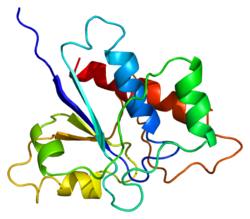

| ACP1 | |||||||||||||||||||||||||||||||||||||||||||||||||||
|---|---|---|---|---|---|---|---|---|---|---|---|---|---|---|---|---|---|---|---|---|---|---|---|---|---|---|---|---|---|---|---|---|---|---|---|---|---|---|---|---|---|---|---|---|---|---|---|---|---|---|---|
 | |||||||||||||||||||||||||||||||||||||||||||||||||||
| |||||||||||||||||||||||||||||||||||||||||||||||||||
| Identifiers | |||||||||||||||||||||||||||||||||||||||||||||||||||
| Aliases | ACP1, HAAP, LMW-PTP, acid phosphatase 1, soluble, LMWPTP, acid phosphatase 1 | ||||||||||||||||||||||||||||||||||||||||||||||||||
| External IDs | OMIM: 171500; MGI: 87881; HomoloGene: 38274; GeneCards: ACP1; OMA:ACP1 - orthologs | ||||||||||||||||||||||||||||||||||||||||||||||||||
| EC number | 3.1.3.2 | ||||||||||||||||||||||||||||||||||||||||||||||||||
| |||||||||||||||||||||||||||||||||||||||||||||||||||
| |||||||||||||||||||||||||||||||||||||||||||||||||||
| |||||||||||||||||||||||||||||||||||||||||||||||||||
| |||||||||||||||||||||||||||||||||||||||||||||||||||
| |||||||||||||||||||||||||||||||||||||||||||||||||||
| Wikidata | |||||||||||||||||||||||||||||||||||||||||||||||||||
| |||||||||||||||||||||||||||||||||||||||||||||||||||
Low molecular weight phosphotyrosine protein phosphatase is an enzyme that in humans is encoded by the ACP1 gene.
The product of this gene belongs to the phosphotyrosine protein phosphatase family of proteins. It functions as an acid phosphatase and a protein tyrosine phosphatase by hydrolyzing protein tyrosine phosphate to protein tyrosine and orthophosphate. This enzyme also hydrolyzes orthophosphoric monoesters to alcohol and orthophosphate. This gene is genetically polymorphic, and three common alleles segregating at the corresponding locus give rise to six phenotypes. Each allele appears to encode at least two electrophoretically different isozymes, Bf and Bs, which are produced in allele-specific ratios. Three transcript variants encoding distinct isoforms have been identified for this gene.[5]
Clinically, increased expression of ACP1 is a biomarker for poor prognosis in prostate cancer has been linked to worse clinical behaviour of prostate cancer, possibly outperforming the widely used Gleason grading system with respect to this important parameter.[6] Also in other cancers, e.g. colon cancer, high ACP1 protein levels are linked to aggressive disease.[7] It has been suggested that ACP1 acts as a bona fide oncogene, but for now this notion remains unproven even if ACP1 overexpression drives cells towards a Warburg effect-like glycolytic phenotype.[8] Apart from cancer, ACP1 has also been linked to osteoporosis as the enzyme plays an important role in the interaction of the osteocyte with the bone environment,[9] while its inhibition appears useful for counteracting experimental [venous thromboembolism].[10] Currently, there are no clinically approved inhibitors that allow targeting ACP1 in patients.
ACP1 has been shown to interact with EPH receptor A2[11] and EPH receptor B1.[12] The proto-oncogene Src has been suggested to be a direct target for ACP1 tyrosine phosphatase activity, but this has not been formally proven.[13]
|
PDB gallery
| |
|---|---|
|
1bvh: SOLUTION STRUCTURE OF A LOW MOLECULAR WEIGHT PROTEIN TYROSINE PHOSPHATASE
1c0e: Active Site S19A Mutant of Bovine Heart Phosphotyrosyl Phosphatase
1dg9: CRYSTAL STRUCTURE OF BOVINE LOW MOLECULAR WEIGHT PTPASE COMPLEXED WITH HEPES
1phr: THE CRYSTAL STRUCTURE OF A LOW MOLECULAR PHOSPHOTYROSINE PROTEIN PHOSPHATASE
1pnt: CRYSTAL STRUCTURE OF BOVINE HEART PHOSPHOTYROSYL PHOSPHATASE AT 2.2 ANGSTROMS RESOLUTION
1xww: Crystal Structure of Human B-form Low Molecular Weight Phosphotyrosyl Phosphatase at 1.6 Angstrom Resolution
1z12: Crystal Structure of Bovine Low Molecular Weight PTPase Complexed with Vanadate
1z13: Crystal Structure of Bovine Low Molecular Weight PTPase Complexed with Molybdate
5pnt: CRYSTAL STRUCTURE OF A HUMAN LOW MOLECULAR WEIGHT PHOSPHOTYROSYL PHOSPHATASE. IMPLICATIONS FOR SUBSTRATE SPECIFICITY
|
|
| |||||||||||||||||||||||
|---|---|---|---|---|---|---|---|---|---|---|---|---|---|---|---|---|---|---|---|---|---|---|---|
| Class I |
| ||||||||||||||||||||||
| Class II |
| ||||||||||||||||||||||
| Class III |
| ||||||||||||||||||||||
| Class IV |
| ||||||||||||||||||||||
This article on a gene on human chromosome 2 is a stub. You can help Wikipedia by expanding it. |